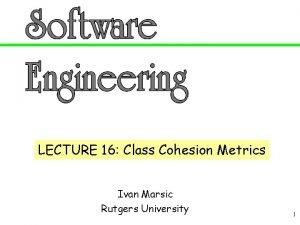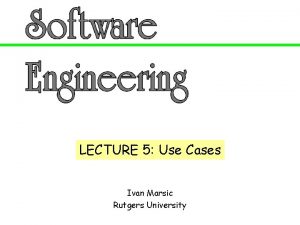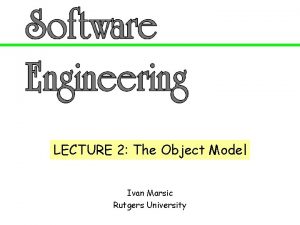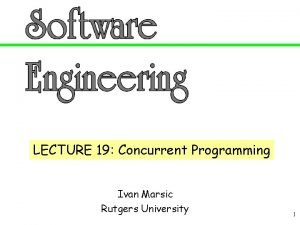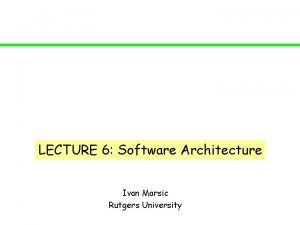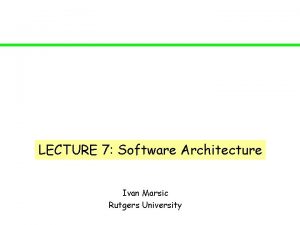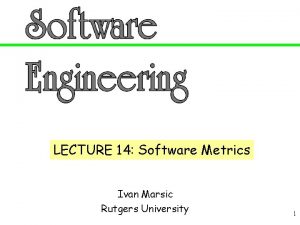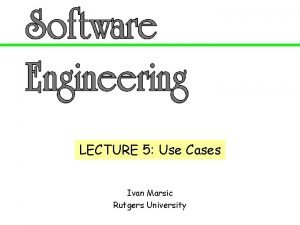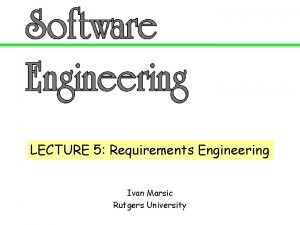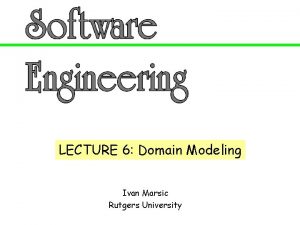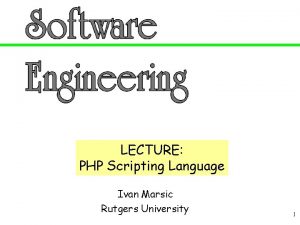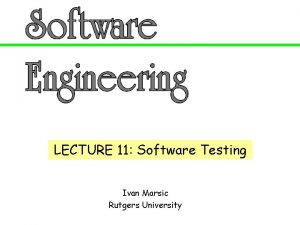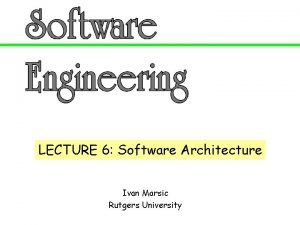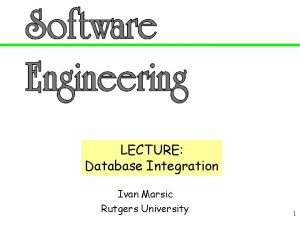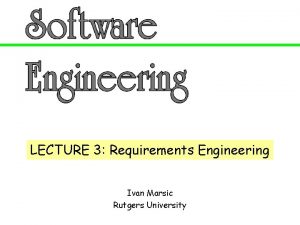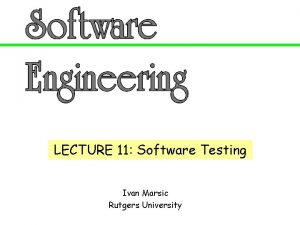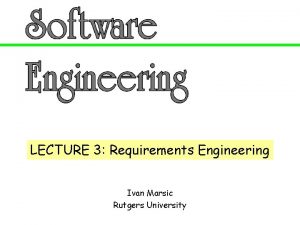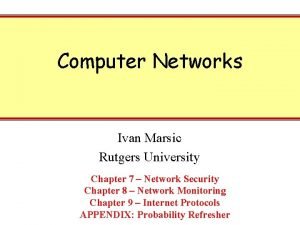LECTURE 19 Concurrent Programming Ivan Marsic Rutgers University













![Where Latency Matters? [ keycode complete ] Read Digits Tenant [else] [ keycode valid Where Latency Matters? [ keycode complete ] Read Digits Tenant [else] [ keycode valid](https://slidetodoc.com/presentation_image/48e292ce7e884baf69f4c5834190b9c4/image-14.jpg)


- Slides: 16

LECTURE 19: Concurrent Programming Ivan Marsic Rutgers University 1

Topics § Threads § Exclusive Resource Access – Exclusion Synchronization § Cooperation between Threads – Condition Synchronization § Concurrent Programming Example 2

Parallelism § What we want: Parallel instead of serial processing, to speed up service § What problems to solve: Concurrent access to a resource (or software object) can lead to conflict ambiguous result or “frozen” program 3

Concurrency: Exclusion Synchronization 4

Thread vs. Process § Process roughly corresponds to a program (*program can “spawn” many processes) § Processes communicate using interprocess communication (pipes, sockets, shared memory, …) – An object from one process cannot directly call a method on an object shared by another process § Threads run in the same program – An object from one thread can directly call a method on an object shared by another thread 5

Concurrent Programming -- Threads Lifecycle of Java threads 6

Thread States: Alive § Alive: After a thread is start()-ed, it becomes alive: – Runnable: The thread can be run when the OS scheduler can arrange it (and nothing prevents it from being run) – Blocked: The thread could be run, but there is something that prevents it (e. g. , another thread is holding the resource needed for this thread to do its work). While a thread is in the blocked state, the scheduler will simply skip over it and not give it any CPU time. A thread can become blocked for the following reasons: • Waiting for notification: Invoking the method wait() suspends the thread until the thread gets the notify() or notify. All() message • Waiting for I/O or lock: The thread is waiting for an input or output operation to complete, or it is trying to call a synchronized method on a shared object, and that object’s lock is not available • Waiting for rendezvous: Invoking the method join(target) suspends the thread until the target thread returns from its run() method • Sleeping: Invoking the method sleep(milliseconds) suspends the thread for the specified time 7

Exclusion Synchronization 8

Example: Bank Account Access by Two Users § Concurrent read/write of the same data by several § threads “race condition” or “race hazard” The outcome of the execution depends on the particular order in which the access takes place Thread 1 Thread 2 old. Balance = . . . account. get. Balance(); new. Balance = old. Balance = old. Balance + deposit; account. get. Balance(); account. set. Balance(new. Balance ); new. Balance = old. Balance - withdrawal; . . . account. set. Balance(new. Balance ); 9

Exclusion Synchronization in Java shared object acquire lock release lock public class Shared. Class { . . . public synchronized void method 1(. . . ) { . . . } } acquire lock release lock public class Any. Class { . . . public void method 2(. . . ) { . . . synchronized (expression) { statement } . . . } shared object } (a) (b) Synchronized Methods Synchronized Statements 10

Condition Synchronization suspend and wait … … resume the suspended work 11

Example: Safe Home Access Central Computer Backyard door: Access lock Front door: Access lock 12

Example of Concurrency Gains Single thread – sequential service (a) Multiple threads – parallel service (b) 13
![Where Latency Matters keycode complete Read Digits Tenant else keycode valid Where Latency Matters? [ keycode complete ] Read Digits Tenant [else] [ keycode valid](https://slidetodoc.com/presentation_image/48e292ce7e884baf69f4c5834190b9c4/image-14.jpg)
Where Latency Matters? [ keycode complete ] Read Digits Tenant [else] [ keycode valid ] Check Validity Activate Devices [else] § While typing in the digits, the user does notice § § latency Latency becomes noticeable when waiting for validity check and device activation Validity computation is quick; device activation may be somewhat slower The longest latency is while the user is typing-in the keycode so we need to allow parallel entry of keycodes on both doors But. . . all communication goes over the same serial cable: 14

Hardware Implementation NOTE: Locks, lightbulb switch (with photosensor) and alarm bell are controlled by the central computer via the same serial port 15

Multithreaded Implementation Main Thread: interacts with serial I/O port Helper Thread: front door calculations and control Helper Thread: back door calculations and control Home. Access. Control. System_2 x + serial. Event(event : Serial. Port. Event) contrl. Front : Controller. Thd contrl. Back : Controller. Thd key. Front : String. Buffer key. Back : String. Buffer Shared Object ( See Listing 5 -6 in the book for details ) 16
 Ivan marsic rutgers
Ivan marsic rutgers Ivan marsic
Ivan marsic Ivan milat deus ex machina
Ivan milat deus ex machina Ivan marsic
Ivan marsic Martina maršić
Martina maršić Synchronization algorithms and concurrent programming
Synchronization algorithms and concurrent programming 01:640:244 lecture notes - lecture 15: plat, idah, farad
01:640:244 lecture notes - lecture 15: plat, idah, farad York u myfile
York u myfile C data types with examples
C data types with examples Perbedaan linear programming dan integer programming
Perbedaan linear programming dan integer programming Greedy programming vs dynamic programming
Greedy programming vs dynamic programming What is in system programming
What is in system programming Integer programming vs linear programming
Integer programming vs linear programming Perbedaan linear programming dan integer programming
Perbedaan linear programming dan integer programming What are delegated reserved and concurrent powers
What are delegated reserved and concurrent powers Concurrent validity nedir
Concurrent validity nedir Concurrent in os
Concurrent in os
